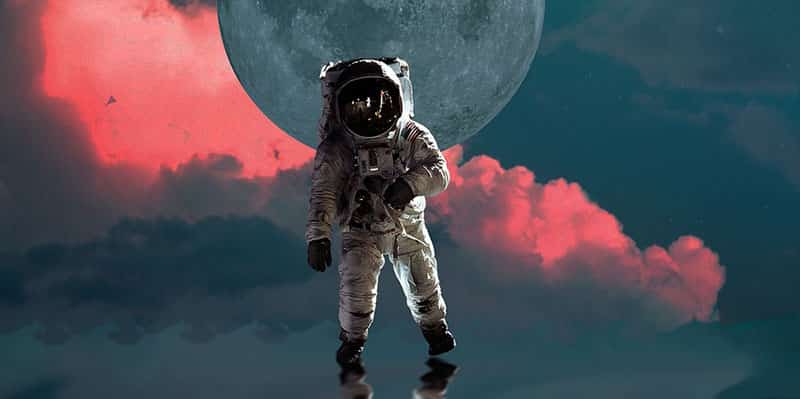Writing a space story inherently means an exploration of the universe as an expanded idea of the world we inhabit. No matter if the genre is hard sci fi or science fantasy, the idea of space exploration is a fundamental human thing. It’s the same impulse that sent prehistoric humans across the oceans in canoes. Now, those boats have been replaced by spacecraft.
Write a space story with these fundamental ideas in mind.
Wonder and Curiosity
Let’s start with the most fundamental inspiration for this genre—curiosity. The cosmos is spectacular. We don’t have to live in today’s age of fast information to know the night sky is mind-blowing. Ever since our ancient ancestors, we’ve had stories of heroes traversing this mysterious cosmos. We want to lean into the extraordinary feeling we get when we look into the night sky.
Of course, in modern times this takes the form of spaceships and futuristic technology, which makes sense in our high-tech age. It’s important not to forget our own primal drive for exploration. This comes from old stories of high adventure—seafaring to unknown lands—and is expanded into the universe.
The heart of telling space exploration stories is based in exploring our own planet, something our ancestors have been doing for thousands of years. Ships become spacecraft, islands become planets, foreigners become aliens.
This launching point can lead us to stores of survival, exploration and even philosophy. A few examples to stoke this curiosity include:
- Technology that seems like magic
- Conscious beings more evolved than humans
- Civilizations with strange cultures
- Planets with unique lifeforms and physics
- Discoveries that change our understanding of the universe
Lean into the weird—because the universe is weird.
Survive the Extreme Elements
No matter the overall purpose of the story, you’re going to have to think about survival in some extreme circumstances. One way or another, space is a foreign environment that can mess with a human body in several ways. Food, water and heat are obvious, but also:
- Air pressure
- Gravity
- Radiation
- Alien organisms that are just compatible enough with earth biology to cause havoc in an unsuspecting astronaut’s brain.
I could go on, but you get the idea. So much can go wrong and often does.
Survival could be the goal that pushes the narrative—something like a Jack London novel in space. In fact, this often is a consideration that pushes the story at some point. If life support has a problem, then your characters are immediately in jeopardy.
What does survival in this unique circumstance (aboard a spaceship, on a planet, navigating a solar system, environment) look like? What does it ask of your main characters?
These details also bring an audience into a story. There is a texture to things—fresh air to breathe, a warm environment to sleep in, adequate food and water. Even if your plan is to blow your audience’s mind, you need to bring them into the story with the senses.
Related Posts:
Writing a Space Western: How to Write Cowboys in Space
| How to Start a Sci Fi Short Story
|
Physics
Obviously, you don’t have to be a physicist to write a fun space story, but knowing a little about the subject goes a long way. This is science fiction, so you should brush up on a little science. Plus, this kind of research can stoke ideas for obstacles or story turns.
Have an ace pilot traversing a field of asteroids or escaping the pull of a black hole? Learning more about the physics of these astral phenomena will give you a strong basis to create a “down-to-earth” approach on how the pilot reacts.
The same is true for planetary exploration. The forces of gravity can be wildly different depending on the size of the planet. Think about the way your characters would navigate this environment. Would they use technology to aid them? Like a super suit for high-gravity environments and flying squirrel wings for low gravity?
Macro Physics
Being explorers of the great beyond, your characters will engage with physics on a macro level. This includes cosmic expansion, gravity fluctuation and other phenomena of deep-space travel. Your characters are going to run into phenomena so big it is hard to describe—black holes, nebula, faster-than-light travel, binary star systems, space-time fluctuations.
You may want to include how these massive forces are going to obscure your characters’ journey through the cosmos. One minute, you’re cruising through hyperspace on your way to an exotic planet. Next, you’re being pulled off course by a freak supermassive black hole. Space is crazy.
On a more positive note, some of the phenomena in deep space are extraordinary. Seeing the rushing lights of hyperspace or swimming through a purple galactic gas would be awesome backdrops to the action in your story. When you are building a world of cosmic wonder, don’t forget to include the wild stuff that goes on up there.
Quantum Physics for Make-Believe
Photons, entanglement, subatomic particles that only sometimes exist—the quantum world is full of bizarre. Can something on one side of the universe be connected to something on the opposite end of the endless expanse? Apparently, yes.
Though you’ll likely see more of the macro physics side of things with interstellar space travel, remember how weird quantum reality is. There is so much in the research that could elevate your space story with a splash of mind-blowing story elements.
The quantum is also the gateway to other universes and realities. So, if you want to take your space adventure into…more space, this might be your gateway. Really, you could do all sorts of creative twists in this alternate reality. Also, quantum physics is a good explainer for warp gates and portals to other worlds.
Naturally, the real trick is to marry the quantum rules with the macro, but real scientists are still trying to work that out.
Alien Ecologies
Alien ecologies can range from oddly Earth-like to the bizarre, depending on the planet’s physics. Naturally, factors like gravity can radically change the way lifeforms develop on a particular planet. This is adventure storytelling on a cosmic level, so consider how radical the environment could be.
Of course, wildlife on these bizarre planets will need to be considered. Is it full of creatures that are built to be the ultimate hunting machine with acid blood? Or, on the other hand, is it full of furry, little, glowing, teddy bear aliens? Maybe both? That would be an interesting environment.
You could include aspects of silicone life or even artificial biology, but carbon is like the Lego of the universe—it’s so easy to build with these things. Obviously, carbon can make an extraordinary variety of lifeforms for any given livable environment. In fact, you may come to find that similar forms arise across the universe—like crabs. I bet the universe is full of crabs.
A few examples of alien ecologies to get your creativity going:
- A complex fungal colony that acts as one and covers an entire planet.
- A seemingly toxic environment that is lush with its own immune lifeforms.
- Bioluminescent everything.
- Desert planets with just enough water to support a life cycle and subterranean ecosystems.
- Water planets with intelligent life that is unable to create technology.
- Artificial life created by a superintelligent alien race.
Intergalactic Civilizations
Finally, we need to think about how our intergalactic civilization works. If we’re cruising through space in an interstellar ship, our story likely has some sort of interplanetary or intergalactic order. This civilization can be dystopian, like in Star Wars, or utopian, like in Star Trek. Maybe it’s somewhere in the middle. Either way, you need to figure out how the civilized world works and how it affects your main characters.
Are there alien civilizations involved in the intergalactic order? What cultures would they bring to the table, and how would your main characters interact with those cultures? Naturally, you want to have tension somewhere with these cultures, whether that means having an alien as a main character or a crew of humans interacting with an alien world.
Let’s dig a bit further into these two concepts.
Having an alien companion is a fantastic way of building conflict within the world. If they are seen as outsiders, maybe your story has elements of friendship and understanding. Maybe your main character has a close relationship with an alien character that the rest of the humans don’t like or understand. Honestly, this is like many great stories of humans on earth where cultures clash. Even if the other character isn’t human, your human characters can find common ground with other conscious beings.
On the other hand, you could lean into the “otherness” of an alien civilization by viewing it through human eyes. Of course, alien civilizations are likely to be bizarre. So, let’s lean into the weirdness and show the audience something fun. You can walk your audience through the idea of accepting an odd custom or way of thinking through this kind of story.
But what about the bad guys?
Your main characters could be in a struggle for survival against a parasitic, warlike or monstrous society. Even in worlds like the Star Trek universe, characters must deal with races that seek domination. As far as we know, war is a part of intelligence. We humans seem to be fond of it. But other threats may lurk in the psyche of conscious minds across the stars, including:
- Cybernetic organisms that eliminate individuality for a hive mind.
- Races that worship war and invade nearby systems.
- Slug-like, parasitic organisms that invade other species to use their bodies.
- Ancient, monarchal societies in space with overwhelming power.
- Super powered organisms with a need to dominate.
- Human Empires—so far, the gold standard.



